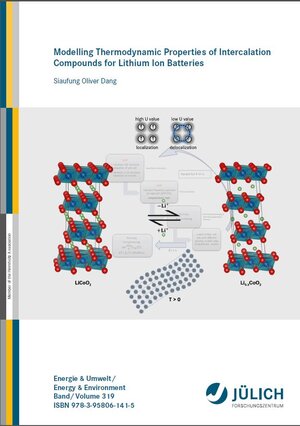
×
![Buchcover ISBN 9783958061415]()
Modelling Thermodynamic Properties of Intercalation Compounds for Lithium Ion Batteries
von Siaufung Oliver DangDFT calculations were employed to model thermodynamic properties on intercalation
compounds for lithium ion batteries. Two compounds were investigated:
the commercially available LixCoO2 and the silicon based LixMg2Si.
The LiCoO2 compound was modelled under two aspects. Firstly, total energy
calculations were carried out on the two-phase region between the delithiated,
metallic phase and the lithiated, semiconducting phase in the attempt to
model the two-phase equilibrium. It was possible to observe that the metallic
state is energetically more stable at low lithium contents agreeing with
experimental evidence. It was, however, not possible to map the two-phase
region properly, most likely due to deficiencies in the applied approach using
a single Hubbard U parameter on the cobalt d-orbitals. The computed average
intercalation voltage was derived for a series of compositional segments
between LiCoO2 and Li0.5CoO2 and demonstrate a good agreement to prior
DFT calculations. Secondly, isobaric heat capacities were calculated within
the quasi-harmonic approximation for three stoichiometries of LixCoO2 ranging
from LiCoO2 to Li0.5CoO2. The results indicate a good agreement with
available experimental data when accounting for the phase impurities of the
sample. Calculations on a boron doped compound LiCo11/12B1/12O2 were
also done and yielded results which fall into the expected range.
In case of LixMg2Si a more elaborate approach was employed to explore the
configurational space of the solid solution in terms of the vacancy arrangements
by using the cluster expansion method (employed software: ATAT).
compounds for lithium ion batteries. Two compounds were investigated:
the commercially available LixCoO2 and the silicon based LixMg2Si.
The LiCoO2 compound was modelled under two aspects. Firstly, total energy
calculations were carried out on the two-phase region between the delithiated,
metallic phase and the lithiated, semiconducting phase in the attempt to
model the two-phase equilibrium. It was possible to observe that the metallic
state is energetically more stable at low lithium contents agreeing with
experimental evidence. It was, however, not possible to map the two-phase
region properly, most likely due to deficiencies in the applied approach using
a single Hubbard U parameter on the cobalt d-orbitals. The computed average
intercalation voltage was derived for a series of compositional segments
between LiCoO2 and Li0.5CoO2 and demonstrate a good agreement to prior
DFT calculations. Secondly, isobaric heat capacities were calculated within
the quasi-harmonic approximation for three stoichiometries of LixCoO2 ranging
from LiCoO2 to Li0.5CoO2. The results indicate a good agreement with
available experimental data when accounting for the phase impurities of the
sample. Calculations on a boron doped compound LiCo11/12B1/12O2 were
also done and yielded results which fall into the expected range.
In case of LixMg2Si a more elaborate approach was employed to explore the
configurational space of the solid solution in terms of the vacancy arrangements
by using the cluster expansion method (employed software: ATAT).


